#elearning content development companies
Explore tagged Tumblr posts
Text
IETM Software & CBT| E-learning Design and Development |Interactive Electronic Technical Manual
Code and Pixels is best among top 10 eLearning companies in Hyderabad, India. Code and Pixels Interactive Technologies Private Limited (C&P) is an E-Learning service provider based in Hyderabad (India). We provide end-to-end E-Learning solutions, specialized in innovative use of technology.
https://www.codeandpixels.net
#what is ietm#ietm developement#ietm classes and levels#ietm viewer#ietm pdf#code and pixels#ietm Level-iv#elearning companies#elearning service provider#elearning solutions#digital education#software development company#elearning content development companies#elearning development companies#lms development companies#e learning software companies#android app development#software development services#custom software development#software development solutions#e learning solutions providers#custom elearning content development#elearning solutions company#custom elearning services#custom elearning development
1 note
·
View note
Text
https://www.mitrmedia.com/resources/blogs/custom-elearning-vs-off-the-shelf-solutions-which-is-right-for-your-business/
Custom eLearning Solutions vs. Off-the-Shelf: What's Best for Your Business?
Explore the benefits of custom eLearning solutions vs. off-the-shelf options to find the perfect fit for your business needs and goals. Learn more now!
#custom eLearning solutions#custom eLearning#custom eLearning development#eLearning content development companies
1 note
·
View note
Text

In today’s fast-paced world, disruptions in education are becoming more common than ever before. With the rise of technology and the increasing demand for online learning, educators must adapt to new teaching methods to ensure student success. In this blog post, we will explore how adaptive online teaching can help you navigate these disruptions and create a elearning content development companies for your students.
0 notes
Text

0 notes
Text
IETM for Beginners A Quick Guide to IETM Code and Pixels
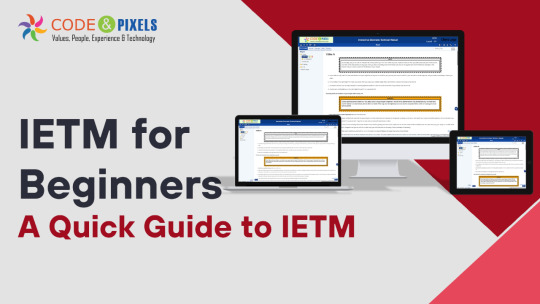
IETM: Interactive Electronic Technical Manual
Training Aids to Defence Client
If you are a supplier of defence then along with the system/equipment you also need to provide Training Aids
(CBT) — Computer-Based Training
Charts and Bloups
Video Film
Training Work Modules
Manuals Hard Copies
IETM
Evolution of Documentation in Defence
Before — Hardcopies and PDFs in DVDs (Upto 2015)
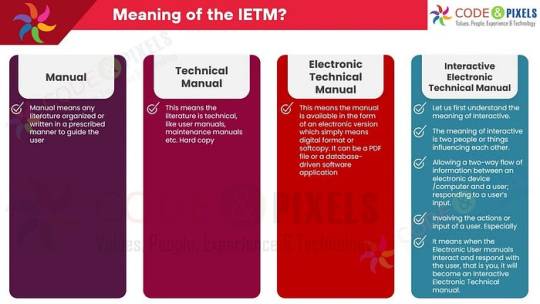
What is the meaning of the IETM?
Manual: Manual means any literature organized or written in a prescribed manner to guide the user.
TechnicalManual: This means the literature is technical, like user manuals, maintenance manuals etc. Hard copy
Electronic Technical Manual: This means the manual is available in the form of an electronic version which simply means digital format or softcopy. It can be a PDF file or a database-driven software application.
Interactive Electronic Technical Manual:
Let us first understand the meaning of Interactive. The meaning of interactive is two people or things influencing each other.
Allowing a two-way flow of information between an electronic device /computer and a user; responding to a user’s input.
Involving the actions or input of a user. Especially
It means when the Electronic User manuals Interact and respond with the user, that is you, it will become an Interactive Electronic Technical manual.
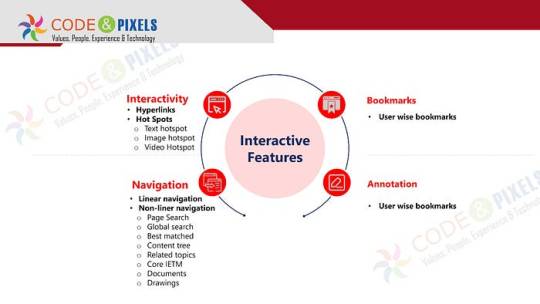
Interactive Features
Interactivity
Hyperlinks
Hot Spots
Text hotspot
Image hotspot
VideHotspot
Bookmarks
User wise bookmarks
Navigation
Linear navigation
Non-liner navigation
Page Search
Global search
Best matched
Content tree
Related topics
Core IETM
Documents
Drawings
Annotation
User wise bookmarks
The documents and pages are many hence, for easy and fast accessibility complete content is converted and stored as a database.
Whenever the user wants some information, IETM software produces the information in a fraction of a second.
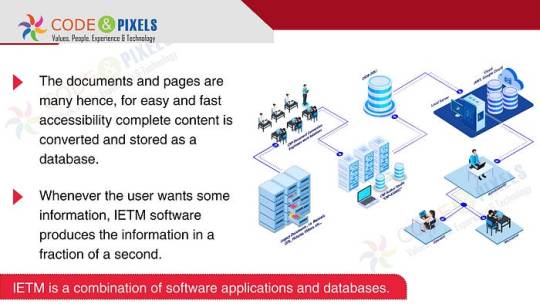
Use or Purpose of the IETM?
The purpose of the Manual is to give information related to the equipment to the end user for quick reference.
All the technicality is written in detail so that when an issue arises, the user can refer to the manual, as every time OEM or technical person or subject matter expert might not be available on the spot to resolve the issue.
If the manual has 10 pages users can refer easily.
But any system used by the defence will have multiple manuals and thousands of page counts and many times a user has to cross-refer between manuals, intra-manual and inter-manual to resolve the issue.
Referring to 10- 15 hard-copy or even soft-copy books simultaneously will be difficult and time-consuming.
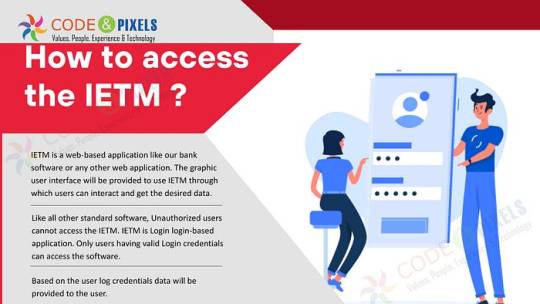
How to access the IETM ?
IETM is a web-based application like our bank software or any other web application. The graphic user interface will be provided to use IETM through which users can interact and get the desired data.
Like all other standard software, Unauthorized users cannot access the IETM. IETM is a Login - login-based application. Only users having valid Login credentials can access the software.
Based on the user log credentials data will be provided to the user.
IETM has 2 types of Users and one Administrator
Maintainer
Operator
If the operator logs in, the user gets all the content related to operator use, similarly if the maintainer logs in only maintenance-related content is visible for that user.
Ideally, all the content is available for both users, because the purpose of the IETM is to refer to the manual to fix the issue.
Administrators can create users who can see the user’s navigation and log-in history and interact with the users using user dashboards through Annotations.
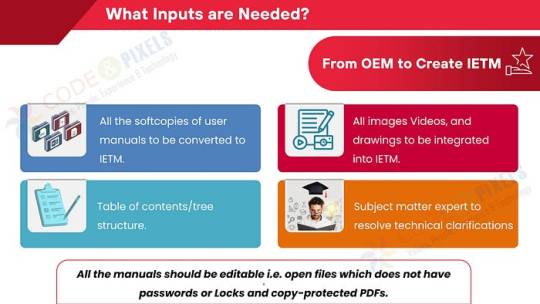
What Inputs are Needed? (From OEM to Create IETM)
All the softcopies of user manuals to be converted to IETM.
All images Videos, and drawings to be integrated into IETM.
Subject matter expert to resolve technical clarifications
Table of contents/tree structure.

Minimum Hardware Requirements?
NO High-end hardware or servers are required to run IETM.
However, if more concurrent users, then a good configuration server with good LAN connectivity must be ensured.
i3 with 8 GB RAM systems is the minimum configuration required for the server or for Node.
Deliverables
BASED DB (Manuals are covered in the Database)
IETM VIEWER Software
User Manual and Installation Manual
Standards — compliance
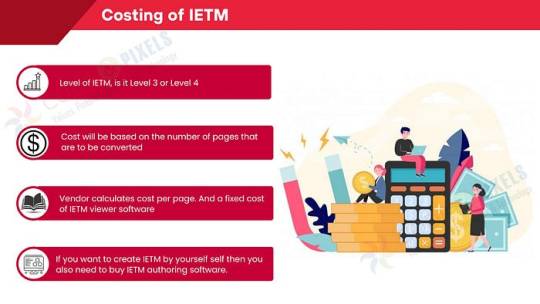
Costing of IETM: (Interactive Electronic Technical Manual)
Level of IETM, is it Level 3 or Level 4
Cost will be based on the number of pages that are to be converted
The vendor calculates the cost per page. And a fixed cost of IETM viewer software
If you want to create IETM by yourself self then you also need to buy IETM authoring software.
What are these Levels?
Level — 1 is any PDF file
Level — 2 is a PDF file with hyperlinks from the table of contents to the body etc.
Level — 3 is an HTML application. More hyperlinks, simple search, a content tree having log a screen with a hardcoded username and password and supplied in the format of EXE so that Windows can easily open
Level — 4 is Software plus Content/manuals converted as Database
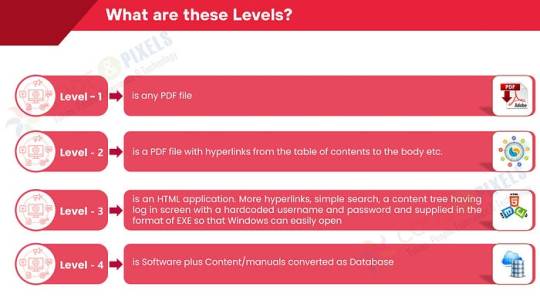
Regarding Level — 5, rest assured, till 2028 it will be Level — 4 only. As of now, there is nothing practically called Level — 5. Few are calling virtual reality and Augmented reality and Artificial intelligence Level — 5.
Pulling data from many user inputs and analyzing and giving results are done in Level — 5. IETM software cannot pull the data from various real-time points as No OEM will give the real-time information to third-party software directly. Yes, if the information is available offline, then that information can be imported into IETM and can be used as a reference.

#ietm#software#technology#ietm developement#ietm code and pixels ietm hyderabad#ietm software#elearning#code and pixels#ietm level iv#codeandpixels#ietm level 4 software requirements#technical documentation#ietm document#ietm documentation#interactive electronic technical manual#Ietm Service Providers#Ietm Software Designers of India#Software Development Company#Elearning Solutions Company#E Learning Content Development Company#Online Education#Digital Education#Digital Content#Software Development Solutions#Elearning#Ietm Developers#Econtent Development#Elearning Solutions Providers#Econtent Developers#Econtent
2 notes
·
View notes
Text

#elearning content development#e learning dubai#content writing companies in dubai#learning and development consultancy#eleaning dubai#k 12 content development#e learning companies in dubai
0 notes
Text
0 notes
Text
Multimedia Content Providers: Top Corporate Video Production Companies
Multimedia Content Providers offer a range of services, including video production, animation, graphic design, and audio production. These companies work with businesses of all sizes to create high-quality content that can be used for social media, websites, digital advertising, and more. They have the expertise and equipment necessary to produce professional content that can capture the attention of consumers and help businesses stand out in a crowded market.
#Multimedia Content Providers#Multimedia Content Development Company#K12 services in india#elearning services in india#e learning companies in india
0 notes
Text

custom elearning solutions
Techsurge Learning specializes in providing custom elearning solutions tailored to the unique needs of organizations. As a trusted provider of custom elearning solutions, we understand that one size does not fit all when it comes to online training and education.
#E Learning Courses#elearning-content-development-companies#Elearningvendors#Elearningsolutions#custom-elearning-solutions
1 note
·
View note
Text

We offer bespoke elearning content development services in UK for primary, secondary and further education For more details call or email us
#elearning content development#elearning solutions london#online course development#e learning development company
0 notes
Text
Reasons Why eLearning is the Future of Professional Development
The professional landscape is in constant flux. New technologies emerge, industries shift, and the necessary work skills for staying competitive are continually evolving. In this dynamic environment, professional development is no longer optional – it's essential.
Traditional professional development methods, like attending in-person workshops or conferences, can be costly, time-consuming, and geographically restrictive. Here's where eLearning shines, providing a flexible, accessible, and effective solution for continuous learning and career growth.
Why eLearning is the Future of Professional Development
Several compelling reasons highlight why eLearning is poised to dominate professional development:
Flexibility: One of eLearning's greatest advantages is its flexibility. Learners can access online courses anytime, anywhere, at their own pace. This accommodates busy schedules, whether early mornings, late nights, or workday breaks. This flexibility is crucial for working professionals juggling various commitments.
Accessibility: eLearning eliminates geographical barriers. Learners worldwide can access top-tier professional development courses from leading experts and institutions. This democratizes knowledge access, empowering individuals to develop essential skills for success, regardless of location.
Cost-Effectiveness: Compared to traditional methods, eLearning is typically more budget-friendly. There are no travel or accommodation expenses associated with in-person events. Moreover, eLearning platforms often offer subscription-based models, providing access to a vast online course library for a fixed fee.
Variety and Customization: The variety of available eLearning courses is vast and expanding. Learners can find courses on virtually any topic, from hard skills like software development or data analysis to soft skills like communication or leadership. Many eLearning platforms offer personalized learning paths, allowing individuals to tailor their development based on specific needs and goals.
Scalability: eLearning enables companies to train numerous employees simultaneously and efficiently. This is particularly beneficial for organizations with dispersed workforces. Additionally, eLearning content can be easily updated to reflect industry standards and best practices.
Engagement and Interactivity: Modern eLearning platforms go beyond static lectures. They incorporate interactive elements like quizzes, simulations, and gamification to maintain learner engagement and motivation. Additionally, some platforms offer discussion forums and social learning opportunities, allowing learners to interact with peers and instructors.
How Guruface Can Help You Achieve Your Professional Development Goals
At Guruface, we believe eLearning is the key to unlocking your full potential. We offer a comprehensive platform packed with features designed to empower your professional development journey:
Extensive Course Library: We provide a vast library of high-quality online courses covering a wide range of in-demand professional skills. Our courses are developed by industry experts and designed to be engaging and informative.
Personalized Learning Paths: Our platform allows you to create personalized learning paths based on your specific needs and career goals. We use intelligent algorithms to recommend courses that will help you bridge your skill gaps and advance your career.
Interactive Learning Experience: We incorporate interactive elements like quizzes, gamification, and discussion forums to keep you engaged and motivated throughout your learning journey.
Performance Tracking and Analytics: Our platform provides detailed insights into your learning progress. You can track your performance, identify areas for improvement, and celebrate your achievements.
Expert Support: Our dedicated support team is available to answer your questions and provide guidance throughout your learning journey.
Invest in Your Future with Guruface
The world of work is rapidly changing. By embracing eLearning with Guruface, you can stay ahead of the curve, develop the skills you need to succeed, and unlock your full professional potential.
Ready to start? Visit our website today to explore our online course library and discover how Guruface can help you achieve your career goals!
0 notes
Text
How the Best eLearning Company Ensures ROI on Training Programs
In today's dynamic and ever-evolving corporate landscape, organizations are prioritizing employee training to enhance productivity, drive innovation, and achieve business goals. eLearning has emerged as a powerful tool to deliver effective training, enabling organizations to educate their workforce in a flexible, scalable, and cost-efficient manner. However, investing in training programs is only worthwhile if it delivers a measurable return on investment (ROI). This is where partnering with the best eLearning company can make a transformative difference.
This article explores how leading eLearning providers ensure ROI on training programs and why businesses must carefully select their learning partners to maximize value.
Defining ROI in eLearning
ROI, or return on investment, in the context of eLearning, refers to the measurable benefits an organization gains relative to the cost of implementing and delivering training programs. A successful eLearning initiative ensures:
Enhanced employee performance and productivity.
Reduction in training costs and operational inefficiencies.
Improved knowledge retention and skill application.
Tangible contributions to organizational goals, such as increased sales, customer satisfaction, or compliance adherence.
The best eLearning company leverages its expertise to align these goals with innovative training solutions, ensuring maximum ROI.
Key Strategies Employed by the Best eLearning Companies to Ensure ROI
1. Needs Assessment and Goal Setting
Before designing a training program, the best eLearning company conducts a comprehensive needs assessment to identify:
The specific skills gaps within the workforce.
The organizational objectives the training aims to address.
The target audience's preferences and learning styles.
This initial analysis ensures that training content is relevant, targeted, and capable of delivering measurable outcomes. By aligning training initiatives with clear goals, organizations can accurately track progress and evaluate success.
2. Customized and Scalable Content Development
Generic training programs often fail to resonate with learners or meet organizational goals. Leading eLearning companies design customized content tailored to an organization’s unique needs, industry, and workforce challenges. Additionally, these programs are scalable, ensuring that organizations can adapt content as they grow or evolve.
For example, a technology firm may require specialized software training, while a healthcare organization may need compliance-focused modules. The best eLearning companies cater to these varied requirements, ensuring that every dollar spent contributes to tangible improvements.
3. Engaging and Interactive Learning Experiences
Learner engagement is critical for knowledge retention and application. Top-tier eLearning providers integrate interactive elements such as quizzes, simulations, gamification, and scenario-based learning to make training sessions immersive and impactful. These features not only maintain learner interest but also facilitate practical application, enhancing the overall effectiveness of the training.
4. Advanced Learning Technologies
The best eLearning companies leverage cutting-edge technologies to create innovative training solutions. These include:
Artificial Intelligence (AI): For personalized learning paths and adaptive content delivery.
Virtual Reality (VR) and Augmented Reality (AR): For realistic simulations and hands-on training experiences.
Learning Management Systems (LMS): For streamlined content delivery, progress tracking, and reporting.
By employing these technologies, eLearning providers ensure that training programs are not only effective but also future-proof.
5. Metrics and Analytics for Continuous Improvement
Tracking and analyzing training outcomes is essential to evaluate ROI. Leading eLearning companies integrate robust analytics tools to measure:
Learner engagement and participation rates.
Assessment scores and knowledge retention.
Behavioral changes and on-the-job performance improvements.
Cost savings compared to traditional training methods.
These insights enable organizations to refine their training programs continually, ensuring sustained ROI.
6. Support and Post-Training Reinforcement
Training doesn’t end with course completion. The best eLearning companies provide ongoing support and reinforcement strategies, such as:
Access to refresher courses and microlearning modules.
Post-training assessments to gauge long-term knowledge retention.
Collaboration tools to encourage peer learning and idea sharing.
Such initiatives ensure that employees can apply their newfound skills effectively, driving consistent business results.
Real-World Success Stories
Case Study 1: Boosting Sales Performance
A global retail company partnered with the best eLearning company to develop a sales training program. The eLearning provider created an interactive, scenario-based course tailored to the organization’s product portfolio and sales strategies. As a result:
Sales representatives improved their knowledge of product features by 40%.
Customer satisfaction scores increased by 25% within six months.
The company saw a 15% rise in overall revenue.
Case Study 2: Ensuring Compliance in Healthcare
A leading healthcare provider faced challenges in maintaining compliance with regulatory standards. By collaborating with an eLearning provider, they introduced VR-based compliance training modules. The results were striking:
Compliance adherence improved from 78% to 95%.
The time spent on training decreased by 30%, reducing operational disruptions.
The organization avoided penalties, saving significant costs.
Choosing the Best eLearning Company for Your Needs
Selecting the right eLearning partner is critical to achieving ROI on training programs. Consider the following factors:
Expertise and Experience: Look for a provider with a proven track record of delivering industry-specific training solutions.
Technology Integration: Ensure they leverage the latest technologies to create engaging and effective learning experiences.
Customization Capabilities: Choose a company that tailors content to your organization’s unique goals and challenges.
Scalability: Opt for a partner who can scale solutions to meet your evolving needs.
Support Services: Assess their post-training support and reinforcement strategies.
Conclusion
Investing in training programs is a strategic move to enhance organizational performance, but achieving measurable ROI requires expertise, innovation, and a learner-centric approach. The best eLearning company acts as a trusted partner, ensuring that every aspect of the training program—from design to delivery—aligns with your business objectives.
By leveraging advanced technologies, creating engaging content, and tracking outcomes, these providers enable organizations to maximize their training investments. As the demand for eLearning continues to grow, choosing the right partner will be pivotal in driving success, ensuring that both employees and organizations thrive in an increasingly competitive world.
0 notes
Text
Elevating Learning Outcomes with Aptara’s Learning Consulting Services and eLearning Development Solutions
In today’s dynamic corporate landscape, effective training and continuous learning have become indispensable for organizations aiming to stay ahead of the curve. Companies are constantly searching for innovative ways to equip their employees with the skills they need to thrive. This is where Aptara’s Learning Consulting Services and eLearning Development Solutions step in, offering comprehensive strategies to optimize learning outcomes and empower businesses.
The Power of Learning Consulting Services
Aptara’s learning consulting services are designed to address the unique challenges organizations face in employee training and development. With a focus on understanding the specific needs of each business, Aptara crafts customized solutions that drive measurable results.
Whether it’s assessing current training programs, identifying gaps, or designing new frameworks, Aptara’s expertise ensures that learning initiatives align perfectly with organizational goals. By collaborating closely with clients, they provide tailored recommendations that maximize employee engagement and boost overall productivity.
Moreover, their services are not limited to strategy alone. Aptara supports companies in implementing these strategies effectively, ensuring that the learning culture becomes an integral part of the organization. The result? Enhanced learning outcomes and a workforce that’s prepared for future challenges.
Innovative eLearning Development Solutions
In the digital age, traditional training methods no longer suffice. Organizations need scalable and engaging solutions that cater to the modern learner. Aptara’s eLearning development solutions address this demand by offering cutting-edge, customized digital training programs.
From interactive modules to immersive virtual simulations, Aptara’s eLearning solutions are designed to captivate learners and ensure knowledge retention. Their expertise in creating dynamic content, coupled with the use of advanced technologies, allows businesses to deliver impactful training experiences.
What sets Aptara apart is their ability to blend creativity with practicality. Their eLearning solutions are not just visually appealing but also deeply rooted in instructional design principles, ensuring that learning objectives are met effectively.
A Partnership for Success
For organizations that require specialized training design, Aptara’s collaboration is a game-changer. They work with companies that provide training design consulting services to deliver tailored solutions that address unique business needs. By combining their expertise with the knowledge of these companies, Aptara creates programs that are both innovative and results-driven.
This partnership ensures that businesses receive holistic support, from the initial consultation to the final implementation. With a strong focus on collaboration, Aptara helps organizations unlock their true learning potential and achieve long-term success.
Why Choose Aptara?
Aptara’s commitment to excellence is evident in every aspect of their services. Their learning consulting services and eLearning development solutions are designed to elevate learning outcomes and transform organizational training programs.
By leveraging their vast experience and innovative approach, Aptara enables businesses to stay competitive in an ever-evolving market. Their solutions not only enhance employee performance but also contribute to creating a positive and growth-oriented work environment.
In conclusion, Aptara’s expertise in learning and development makes them the ideal partner for organizations looking to optimize their training efforts. With their tailored strategies and cutting-edge solutions, Aptara empowers businesses to achieve their goals and unlock new opportunities for growth.
So, if you’re ready to take your organization’s learning outcomes to the next level, partner with Aptara today and experience the difference they can make
Discover more about - Aptara's Expertise in Custom eLearning Development: Tailored Solutions for Corporate Training
0 notes
Text

0 notes
Text
Training for Excellence: Developing Skills in Quality Assurance Practices
Developing Skills in Quality Assurance Practices
Introduction In today’s competitive market, the success of quality assurance services companies hinges on the skills of their QA teams. With advancements in technology and evolving client expectations, continuous training is no longer optional—it’s essential. Companies that invest in skill development ensure their teams are prepared to address challenges efficiently while maintaining high-quality standards.

This article delves into how organizations can foster excellence by developing effective training programs, the benefits of such initiatives, and strategies for long-term success.
1. Why Training is Non-Negotiable in Quality Assurance
Training in quality assurance isn’t just about keeping up with industry trends; it’s about building a resilient team capable of navigating complex projects. Here’s why training matters:
Adapting to Change: The shift from manual to automated testing demands new skills.
Boosting Productivity: Well-trained teams work faster and with fewer errors.
Ensuring Compliance: Industries like healthcare and finance require adherence to strict standards.
Enhancing Client Trust: Skilled QA teams deliver reliable outcomes, fostering client confidence.
Quality assurance services companies that prioritize training gain a competitive edge by delivering exceptional results.
2. Key Areas of Skill Development for QA Teams
Training programs should cover a wide spectrum of skills to ensure comprehensive growth:
a. Technical Proficiency
Test Automation Tools: Mastery of tools like Selenium, TestNG, and JMeter.
Performance Testing: Ensuring applications can handle real-world usage scenarios.
Security Testing: Identifying vulnerabilities and preventing cyber threats.
b. Methodology Training
Agile and DevOps practices.
CI/CD pipeline integration for seamless delivery.
c. Soft Skills
Communication: Articulating findings clearly to stakeholders.
Analytical Thinking: Solving complex issues effectively.
d. Industry-Specific Knowledge
Tailored training helps teams understand sector-specific requirements, such as GDPR compliance in finance or FDA regulations in healthcare.
3. Designing an Effective QA Training Program
Step 1: Assess Needs and Set Goals
Conduct a skills gap analysis.
Define measurable objectives, such as increasing automation coverage by 20% in six months.
Step 2: Develop Custom Curriculums
Include technical, methodological, and soft skill components.
Use a mix of theoretical learning and hands-on practice.
Step 3: Leverage Multiple Training Formats
Classroom sessions for in-depth discussions.
eLearning modules for flexible, self-paced learning.
On-the-job training for real-world application.
Step 4: Foster a Feedback Culture
Encourage trainees to provide input on the program’s effectiveness for continuous improvement.
4. Best Practices for Implementing Training Programs
a. Align Training with Business Goals
Training initiatives should align with organizational objectives, such as reducing defects or improving time-to-market.
b. Personalize the Experience
Different roles within a QA team have unique needs. Tailor training content for:
Testers: Focus on automation and exploratory testing.
QA Leads: Emphasize project management and client interaction.
c. Encourage Continuous Learning
Promote certifications like ISTQB or advanced automation courses to motivate team members.
5. Overcoming Training Challenges in QA
Challenge 1: Time Constraints
Solution: Incorporate microlearning sessions that fit into tight schedules.
Challenge 2: Budget Limitations
Solution: Use cost-effective platforms like Udemy, LinkedIn Learning, or in-house training resources.
Challenge 3: Resistance to Change
Solution: Highlight how training enhances career growth and job satisfaction.
6. Measuring the Impact of Training
Evaluate the effectiveness of training programs using the following metrics:
Defect Detection Efficiency (DDE): Higher efficiency indicates improved skills.
Time-to-Resolution: Faster problem-solving reflects better training.
Employee Satisfaction: Regular surveys help gauge team morale and engagement.
7. The Role of Leadership in QA Training
Leadership plays a vital role in the success of training initiatives. QA managers should:
Lead by Example: Participate in training to set a positive precedent.
Provide Support: Ensure resources and tools are available for learning.
Celebrate Successes: Recognize milestones achieved through training efforts.
8. Case Study: Transforming QA Teams Through Training
Scenario: A mid-sized quality assurance services company faced challenges with delayed project deliveries due to low automation adoption.
Solution:
Conducted a skills gap analysis to identify training needs.
Partnered with an external training provider for a six-week automation bootcamp.
Implemented peer mentoring programs for knowledge sharing.
Results:
Automation test coverage increased by 50%.
Project delivery timelines improved by 30%.
Employee satisfaction scores rose significantly.
9. The Future of QA Training
As technologies like AI and machine learning redefine quality assurance, QA teams must stay ahead by learning:
AI-driven testing tools.
Data analysis and predictive modeling.
Blockchain and IoT testing.
Companies that proactively invest in these areas will remain at the forefront of innovation.
Conclusion
In an industry where precision and efficiency are paramount, training is the cornerstone of success for quality assurance services companies. By designing thoughtful and impactful programs, organizations can build teams that deliver exceptional results while staying ahead of industry trends.
#qualityassuranceservices#qualityassurancecompany#quality assurance services#qualityassurancetesting#softwaretesting
0 notes
Text
What are these Levels -Code and Pixels IETM
Code and Pixels Interactive Technologies Private Limited (CNP) is an IT service provider based in Hyderabad (India). We provide end-to-end eLearning solutions and IETM development (INDIAN STANDARD IETM JSG 0852:2001, LEVELS 3,4,5 and European Aviation Standard IETM Level4 ), specialized in innovative use of technology.

#ietm level 4 software requirements#technical documentation#ietm developement#ietm document#ietm documentation#interactive electronic technical manual#Ietm Service Providers#Ietm Software Designers of India#Software Development Company#Elearning Solutions Company#E Learning Content Development Company#Online Education#Digital Education#Digital Content#Software Development Solutions#Elearning#Ietm Developers#Econtent Development#Elearning Solutions Providers#Econtent Developers#Econtent#Mobile Learning#What is Html5#Software Solutions#Software Development & E-learning Solutions
1 note
·
View note